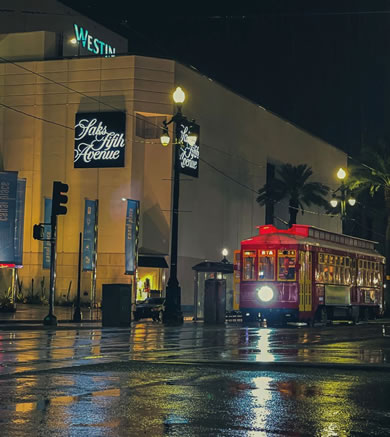
Take a stroll along Canal Street and you’ll get a flavor for the city itself. Trolley cars. The French Quarter. Central Business District. New Orleans’s luxury shops. Dining. Entertainment. And the mighty Mississippi River are all situated along this historical thoroughfare. Even the NFL’s Saints marched down this street in celebration of their Super Bowl XLIV triumph. But to get a better sense of what Canal Street means to New Orleanians, you need to go back to the beginning.
Canal Street: The Waterway that Wasn’t
It was 1807, four years after the Louisiana Purchase, and Americans from across the current Midwest were coming to New Orleans in droves; settling next to the established Creole population. A roadway, which was scheduled to be dug into a canal linking the Mississippi River, Bayou St. John, and Lake Pontchartrain, served as a de facto dividing line between the two cultures. While the waterway was never built, the name stuck, and Canal Street was born.
Clashing of Cultures
Over the years, tensions between the two groups on opposing sides of the street would occasionally flare up. However, Canal Street itself came to be known as “neutral ground,” a place for all cultures to mix and mingle. The connotation applies today as all street medians in the city are referred to as “neutral grounds.”
In the decades that followed, Canal Street thrived as a commercial, entertainment and residential district. It even had the distinction of becoming one of the first places in the world, along with London, Paris, and New York, to be completely lit with electric lights. The tantalizing glow welcomed millions who sought to do some shopping in New Orleans.
The Mecca of Shopping in New Orleans

While not many stores remain from the early 20th century, aside from menswear store Rubensteins, and Meyer the Hatter, Canal Street is still home to retail and luxury shops in New Orleans.The centerpiece of which occupies the first three floors of One Canal Place, an office tower built in 1979. Today, Canal Place offers tourists and New Orleanians alike luxury fashion and beauty brands, home goods, boutique clothing stores and more. Shoppers can also peruse other Riverwalk stores on Canal Street featuring over 140 different shops including outlets. And if you follow Canal Street all the way to the river, you’ll end up near the Riverwalk Mall, a great place to cap off a successful shopping spree.
Going to the Movies
Movie theaters also have a long history on Canal Street. Vitascope Hall, which opened its doors in 1896, is considered to be the world’s first movie theater to function as a business specifically showing films for profit. Although it and several other early 20th century movie houses no longer exist, many cinemas currently operate on Canal Street, including the Prytania Theatres at Canal Place.
History Is Still Being Made
Known as one of the widest streets in the country with its three lanes of traffic in each direction and two trolley car lanes in the middle, Canal Street is also one of the most celebrated. And a must visit for any history buff.
Ready to experience it all? Canal Place is a great first stop. Explore Downtown New Orleans’s premier shopping destination for luxury fashion and beauty brands, boutique clothing stores, home goods and much more. Its world-class retailers—like Louis Vuitton—and locally celebrated designers—such as Reagan Charleston —are sure to make your New Orleans shopping experience an unforgettable one. Visit today!

